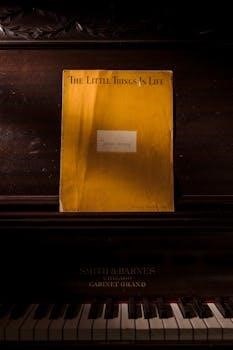Rachmaninoff Piano Concerto No. 2 PDF⁚ A Comprehensive Guide
This comprehensive guide delves into Sergei Rachmaninoff’s Piano Concerto No. 2, a cornerstone of the Romantic repertoire. We’ll explore its historical context, analyze its movements, and guide you to resources where you can download the score in PDF format for in-depth study and performance.
Sergei Rachmaninoff’s Piano Concerto No. 2 in C minor, Op. 18, stands as a monumental achievement in the realm of classical music. Composed between the autumn of 1900 and April 1901, this concerto not only solidified Rachmaninoff’s reputation as a composer but also remains one of his most beloved and frequently performed works. Its enduring popularity stems from its captivating melodies, rich harmonies, and the profound emotional depth it conveys.
This concerto is a quintessential example of Romantic-era composition, characterized by its expansive orchestration, virtuosic piano writing, and a deeply personal expressive language. The work’s structure, adhering to the traditional three-movement concerto form, provides a framework for Rachmaninoff’s musical narrative to unfold. Each movement offers a unique exploration of themes, showcasing both the piano’s lyrical capabilities and its capacity for dramatic power.
For pianists, conductors, and music enthusiasts alike, studying the score of the Piano Concerto No. 2 is an essential endeavor. Fortunately, the score is widely available in PDF format, making it accessible for analysis, performance preparation, and general appreciation. This guide provides a pathway to understanding and accessing this iconic piece.
Historical Context and Composition
The creation of Rachmaninoff’s Piano Concerto No. 2 is deeply intertwined with a period of personal and professional turmoil in the composer’s life. Following the disastrous premiere of his Symphony No; 1 in 1897, Rachmaninoff suffered a severe bout of depression and a creative block that lasted several years. This period of self-doubt and artistic paralysis threatened to derail his career.
Seeking help, Rachmaninoff underwent hypnotherapy with Dr. Nikolai Dahl, a physician and amateur musician. These sessions proved instrumental in restoring his confidence and reigniting his creative spark. The Piano Concerto No. 2 became a testament to this recovery, a triumphant return to form that resonated deeply with audiences.
The concerto was composed between the autumn of 1900 and April 1901. Its second and third movements were first performed in December 1900, with Rachmaninoff himself as the soloist. The complete concerto premiered in 1901 and was immediately acclaimed as a masterpiece. The work is dedicated to Dr. Dahl in recognition of his crucial role in Rachmaninoff’s recovery and the concerto’s very existence. The piece reflects the composer’s renewed sense of hope and artistic purpose.
Availability of the Score in PDF Format

The enduring popularity of Rachmaninoff’s Piano Concerto No. 2 has made its score readily available in various formats, with the PDF format being particularly convenient for musicians and enthusiasts. The accessibility of the score in PDF form allows for easy viewing, printing, and digital annotation, making it an invaluable resource for both study and performance. Whether you are a seasoned pianist preparing for a concert or a student analyzing the intricacies of the composition, having the score at your fingertips is essential.
Numerous online platforms offer the complete score of the concerto in PDF format. These digital versions often include both the two-piano reduction and the full orchestral score, catering to different needs. The two-piano score is ideal for practice and rehearsal, allowing pianists to familiarize themselves with the solo part and the orchestral accompaniment. The full orchestral score, on the other hand, provides a comprehensive view of the entire composition, enabling conductors, musicologists, and dedicated listeners to delve into the rich orchestration and harmonic complexities of the work.
The availability of the score in PDF format democratizes access to this masterpiece, allowing anyone with an internet connection to explore its beauty and depth.
Where to Download Free PDF Sheet Music
Finding free PDF sheet music for Rachmaninoff’s Piano Concerto No. 2 is easier than you might think, thanks to the numerous online resources dedicated to preserving and sharing classical music scores. Several reputable websites offer legal downloads of the concerto’s score in PDF format, often including both the two-piano version and the full orchestral score. One of the most well-known resources is the International Music Score Library Project (IMSLP), a vast online library of public domain music scores. IMSLP boasts a comprehensive collection of classical works, including various editions of Rachmaninoff’s concerto.
When searching for free PDF sheet music, it’s crucial to ensure that you are downloading from a legitimate source to respect copyright laws and support the preservation of musical heritage. Websites like IMSLP operate under a Creative Commons license, providing access to scores that are no longer under copyright protection. Other reputable sources include university libraries and online music databases that offer free access to public domain scores.

Before downloading, always check the edition and arrangement of the score to ensure it meets your specific needs. Some versions may be scanned copies of older editions, while others may be newly typeset versions with improved readability.
Two-Piano Score vs. Full Orchestral Score
When exploring the Rachmaninoff Piano Concerto No. 2 in PDF format, you’ll likely encounter two primary versions of the score⁚ the two-piano reduction and the full orchestral score. Understanding the difference between these versions is crucial for selecting the right score for your specific needs and purposes.
The two-piano score is an arrangement of the concerto designed for two pianists. In this version, one piano typically plays the solo part, while the other piano plays a reduction of the orchestral accompaniment. This arrangement is widely used for practice, rehearsal, and study purposes, allowing pianists to familiarize themselves with the concerto’s solo part and the overall harmonic and melodic structure without the need for a full orchestra.

On the other hand, the full orchestral score presents the complete musical text of the concerto, including all instrumental parts. This version is essential for conductors, musicologists, and anyone seeking to understand the full scope and complexity of Rachmaninoff’s orchestration. It provides a comprehensive view of the interplay between the solo piano and the various instrumental sections of the orchestra.
Analysis of the Movements (with PDF Examples)
Rachmaninoff’s Piano Concerto No. 2 is structured in three distinct movements, each possessing its unique character and contributing to the overall emotional arc of the piece. A detailed analysis of each movement, accompanied by examples from the PDF score, provides invaluable insights into Rachmaninoff’s compositional genius.
The first movement, Moderato, opens with a series of somber chords on the piano, setting a melancholic tone that pervades much of the movement. The interplay between the piano and orchestra is evident from the beginning, with the piano presenting the main themes and the orchestra providing rich harmonic support.
The second movement, Adagio sostenuto, offers a contrasting mood of serene beauty. The movement features a lyrical melody played by the strings, followed by the piano’s expressive response. The PDF score reveals Rachmaninoff’s masterful use of dynamics and orchestration to create a sense of intimacy and emotional depth.
The third movement, Allegro scherzando, bursts forth with energy and vitality. The movement is characterized by its rhythmic drive, virtuosic piano writing, and soaring melodies. The PDF score showcases Rachmaninoff’s ability to seamlessly blend contrasting musical ideas, creating a thrilling and satisfying conclusion to the concerto.
Movement 1⁚ Moderato
The opening Moderato of Rachmaninoff’s Piano Concerto No. 2 immediately establishes the concerto’s introspective and emotionally charged atmosphere. The movement begins with a series of solemn chords played by the piano, creating a sense of foreboding and setting the stage for the themes to unfold. These chords, simple yet profound, demonstrate Rachmaninoff’s ability to evoke deep emotions with minimal material.
As the movement progresses, the orchestra enters, adding layers of complexity and richness to the sonic texture. The interplay between the piano and orchestra is a defining feature of the Moderato, with the piano often presenting the main melodic ideas and the orchestra providing harmonic support and countermelodies. The PDF score reveals Rachmaninoff’s meticulous attention to detail in balancing the two forces, ensuring that neither overpowers the other;
The themes presented in the Moderato are characterized by their lyrical beauty and melancholic quality. The piano writing is both virtuosic and expressive, demanding technical prowess while also allowing for a wide range of emotional expression. The movement’s overall structure is a modified sonata form, with the exposition, development, and recapitulation sections clearly defined. The Moderato serves as a powerful and evocative introduction to the concerto as a whole.
Movement 2⁚ Adagio sostenuto
The Adagio sostenuto, the second movement of Rachmaninoff’s Piano Concerto No. 2, offers a serene and emotionally resonant contrast to the preceding Moderato. This movement is famed for its lyrical beauty and the touching dialogue between the piano and orchestra, creating an atmosphere of tenderness and introspection. The movement opens with a delicate melody in the strings, establishing a sense of tranquility and setting the stage for the piano’s entrance.
The piano enters with a soaring, heartfelt theme that is both memorable and deeply moving. The interaction between the piano and orchestra is particularly exquisite in this movement, with each instrument taking turns presenting and developing the main themes. The PDF score highlights Rachmaninoff’s masterful orchestration, which creates a rich and colorful sonic tapestry. The movement’s harmonies are lush and Romantic, contributing to its overall emotional impact.
The Adagio sostenuto also features a contrasting middle section, which is more animated and passionate than the surrounding sections. This section provides a brief moment of intensity before returning to the serene atmosphere of the opening. The movement concludes with a quiet and peaceful coda, leaving the listener with a sense of contentment and reflection. The Adagio Sostenuto is a testament to Rachmaninoff’s melodic gift and his ability to evoke deep emotions through music.
Movement 3⁚ Allegro scherzando
The Allegro scherzando, the final movement of Rachmaninoff’s Piano Concerto No. 2, provides a vibrant and energetic conclusion to the work. Marked by its rhythmic drive and virtuosic piano writing, this movement showcases Rachmaninoff’s brilliance as both a composer and a pianist. It bursts forth with an infectious energy, immediately captivating the listener with its bold and assertive character. The movement’s opening theme is characterized by its playful and capricious nature, setting the tone for the spirited exchange between the piano and orchestra.
Throughout the Allegro scherzando, the piano takes center stage, displaying a dazzling array of technical feats. Rapid scales, intricate arpeggios, and powerful chords abound, demanding both precision and stamina from the performer. However, the movement is not merely a display of virtuosity; it also features moments of lyrical beauty and melodic invention. The orchestra plays an equally important role, providing a colorful and dynamic backdrop for the piano’s pyrotechnics.
The PDF score reveals the intricate interplay between the piano and orchestra, showcasing Rachmaninoff’s masterful orchestration. The movement culminates in a triumphant coda, bringing the concerto to a resounding and satisfying conclusion. The Allegro scherzando is a tour de force of Romantic piano writing, leaving the audience breathless with its energy and brilliance. It serves as a fitting capstone to Rachmaninoff’s masterpiece, solidifying its place as one of the most beloved piano concertos of all time.
Resources for Further Study (IMSLP, etc.)

For those seeking to delve deeper into Rachmaninoff’s Piano Concerto No. 2, a wealth of resources are available to enhance your understanding and appreciation of this iconic work. The International Music Score Library Project (IMSLP) stands as a cornerstone for accessing public domain scores, including various editions of the concerto. Here, you can find the full orchestral score, the two-piano reduction, and even individual instrumental parts, offering invaluable insights into the composer’s intentions and the intricate details of the music.
Beyond IMSLP, numerous online platforms and academic databases provide scholarly articles, analyses, and historical context surrounding the concerto. These resources can shed light on Rachmaninoff’s compositional process, the influences that shaped his style, and the reception of the work throughout history. Furthermore, exploring recordings by renowned pianists and orchestras can offer diverse interpretations and performance practices, enriching your own understanding of the music’s expressive potential.
Consider exploring books dedicated to Rachmaninoff’s life and works, which often provide detailed analyses of his major compositions, including the Piano Concerto No. 2. These resources can offer valuable insights into the composer’s personal struggles and triumphs, as well as the cultural and historical context in which the concerto was created. By engaging with these diverse resources, you can embark on a rewarding journey of discovery, deepening your appreciation for the artistry and genius of Rachmaninoff’s masterpiece. Don’t hesitate to use these resources to unlock the secrets behind this timeless concerto.